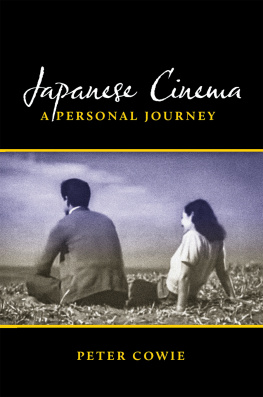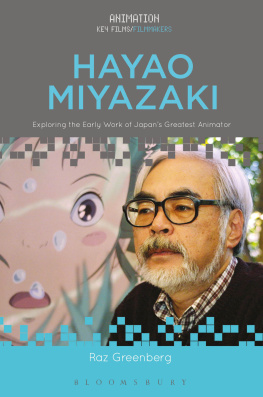Miyazakiworld
Miyazakiworld
A LIFE IN ART
Susan Napier

Copyright 2018 by Susan Napier.
All rights reserved.
This book may not be reproduced, in whole or in part, including illustrations, in any form (beyond that copying permitted by Sections 107 and 108 of the U.S. Copyright Law and except by reviewers for the public press), without written permission from the publishers.
Yale University Press books may be purchased in quantity for educational, business, or promotional use. For information, please e-mail (U.K. office).
Designed by Sonia L. Shannon.
Set in The Sans type by Integrated Publishing Solutions.
Printed in the United States of America.
Library of Congress Control Number: 2017958122
ISBN 978-0-300-22685-0 (hardcover : alk. paper)
A catalogue record for this book is available from the British Library.
This paper meets the requirements of ANSI/NISO Z39.48-1992 (Permanence of Paper).
10 9 8 7 6 5 4 3 2 1
For Steve: In memory of a snow-splashed angel
CONTENTS
PROLOGUE
In Search of Miyazakiworld
On a gray Sunday in February 2014 I drag a little suitcase through rolling woodland paths outside Nagoya, Japan, to visit the sole remnant of the 2005 Aichi World Expo. The twenty-first centurys first worlds fair (121 nations exhibiting on the theme of humans harmonious coexistence with nature) drew twenty-two million visitors over six months, but its greatest attraction, and the goal of my journey, wasnt a 3D ride or a woolly mammoth. Rather, it was a replica of a modest country house from the 1988 Japanese animated film My Neighbor Totoro (Tonari no Totoro). The house is known as Satsuki and Meis House in honor of the two young sisters who live in the house with their father while their mother lies ill in a nearby sanatorium. Although the girls do encounter natural wonders around their woodland home, it is less their coexistence with nature that draws so many visitors than their discovery of a large, furry magical being who can fly with the aid of a spinning top and an umbrella, make plants grow exponentially fast, and find lost children. This creature, whom the sisters call Totoro, becomes a quiet, benign presence lending enchantment to their lives.
And, over the years, the lives of tens of millions of animated-film viewers. Totoro, Mei, and Satsuki are characters in one of eleven feature-length animated films directed by Hayao Miyazaki since 1978. Miyazaki officially retired in 2013, at the age of seventy-two, but came out of retirement in 2017 and is now superintending the development of another film, to be released perhaps as early as 2020. Over his tenure, anime, especially Miyazakis work, has gone from drawing a chiefly Japanese audience to being truly international, touching the lives of so many that, twelve years after the Expos conclusion, the local prefectural authorities keep Satsuki and Meis House open. It remains eerily vacant except for prearranged thirty-minute tours, such as the one Im joining. Im quite conscious of a strange admixture of the real and the unreal as I plod on through occasional rain showers in the largely abandoned fairgrounds. At the fairs entrance there was nowhere to check my suitcase (full of books and articles in Japanese on Miyazaki), so it gets heavier and heavier until I am finally able to leave it behind an umbrella stand at the house.
What inspires me to visit Satsuki and Meis House is what has inspired millions in Japan and around the globe, a love of what I call Miyazakiworld, the immersive animated realm that varies delightfully from film to film but is always marked by the directors unique imagination. At my home university in America I teach a seminar on Miyazaki in which I explain to my students that Miyazaki is an auteura director whose personal and artistic vision is so strong that each film consistently contains trademarks that make his or her entire work a distinctive cinematic experience. Even some of my students are skeptical at first: Can an animation director really be an auteur? they ask.
Yes, he can, as I hope to show in this book. If anything, animators have even more control over their aesthetic product than live-action directors do, and Miyazaki is someone whose detailed artistry extends to the way his characters hair blows in the wind. This controlling master vision enables Satsuki and Meis House to be a perfect replica of the one in the movie, based, as it is, on Miyazakis painstakingly realized drawings. As the tour moves slowly through the house, everyone seems united by a pleasing familiarity. We have all been here before: in the study of the sisters archaeologist father, packed with books and artifacts pertaining to Japans prehistoric Jomon period; in the fully equipped 1950s-style kitchen, where ten-year-old Satsuki proudly makes bento boxes for her father and little sister; in the old-fashioned bath with two tubsone for rinsing and the other for soaking. It is while taking a family bath that the girls learn a valuable lesson from their fatherto laugh and be resilient in the face of darknessand that almost mystical combination of courage, acceptance, and joy is the emotional core of Miyazakiworld. While Miyazakis vision has darkened over time, Miyazakiworld is still a realm where hope triumphs over despair.
I FIRST ENCOUNTERED Miyazakis work more than a quarter-century ago, when I saw Nausica of the Valley of the Wind (Kaze no tani no Naushika, 1984). A postapocalyptic science fiction fantasy, the film intrigued me partly because of its surreal beauty and its surprisingly nuanced vision of technology, humanity, and nature. Most compelling, however, was the moral complexity of its young female protagonist, Nausica, and her interactions with the denizens of her postapocalyptic Earthhuman, animal, insect, and plant. They not only showed a thinking person with a subtle, compassionate mind but also evoked a world that was far more multifaceted than a conventional science fiction moviesor most movies, for that matter.
Nausica, named for Miyazakis favorite heroine in The Odyssey, is Miyazakis alter ego: passionate, angry, judgmental, sentimental, and ultimately apocalyptic, as evidenced in the startling ending of the manga version of Nausica, a thousand-page epic comic that Miyazaki completed twelve years after the movie. It is hardly surprising that Miyazaki, born into war-torn Japan, should be sensitive to technological and environmental catastrophe, and there is a side of him that imagines world-ending events as cathartic, even purgative. I want to see the sea rise over Tokyo and the NTV tower become like an island, Miyazaki once told an American journalist. Money and desireall that is going to collapse and wild green grasses are going to take over.
Apocalyptic imagery is a staple of much of Japanese animation, but in Miyazakiworld it is often females who lead us through the endtimes. At a time when female characters still tended to be sidekicks or romantic interests in Japanese cinema, Miyazaki conjured up a battery of unforgettable young women: Lana, Nausica, Sheeta, San, Chihiro, Ponyo. Often they are associated with nature and the supernatural, expressing the animistic vision that underlies much of Miyazakiworld. And these are only the preteen or teenage heroines: Miyazaki is also one of the few directors in the world who consistently created roles for older women: Dola, Eboshi, Gina, Sophie, and Toki.
Children also constitute a major focus. The director has stated, The child is proof that the world is beautiful, and in Miyazakiworld, childhood becomes a utopian site, reminding us of what we could be if somehow that innocence were recaptured. Miyazakis ability to create an entire story through a childs viewpoint in a film such as
Next page










